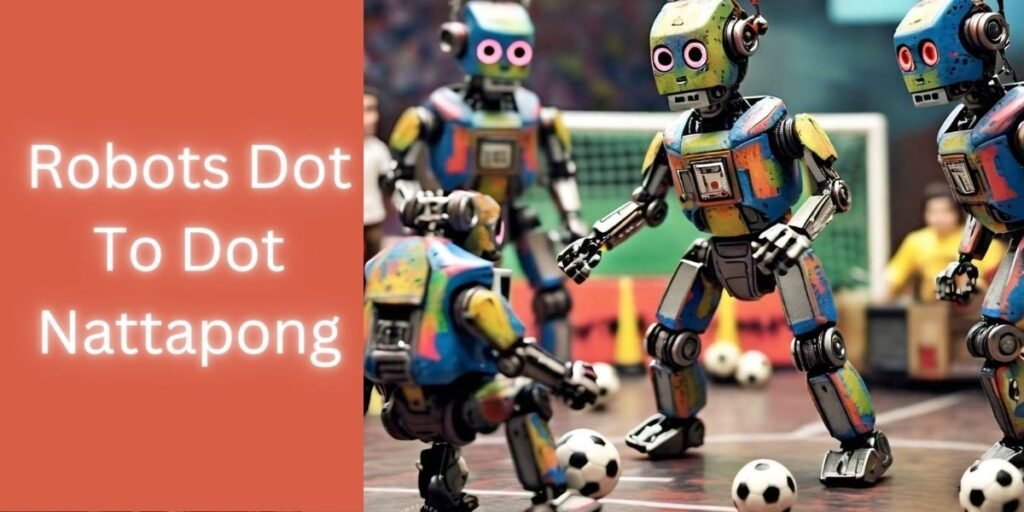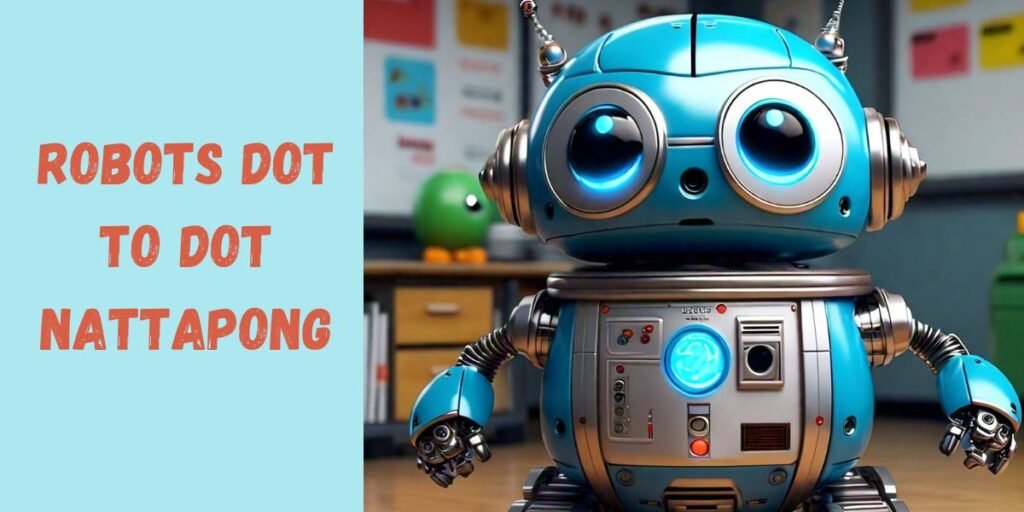In today’s rapidly evolving world, technological innovation continues to transform every aspect of our lives. One fascinating development is Robots Dot To Dot Nattapong—a cutting-edge technology that blends education, creativity, and robotics to engage users, particularly students, in a hands-on learning experience. Whether you’re a teacher, student, or simply someone interested in the ever-growing field of robotics, the concept of Robots Dot To Dot Nattapong presents an exciting opportunity to develop essential skills like problem-solving, creativity, and technical know-how. This article delves deeply into what Robots Dot To Dot Nattapong is, its significance, and how educators and learners alike can benefit from it.
Understand Robots Dot To Dot Nattapong: What is it Exactly?
At its core, Robots Dot To Dot Nattapong is an educational and creative robotics activity designed to help users, especially students, understand robotics in a practical, hands-on way. The “Dot to Dot” aspect refers to a method of connecting ideas, concepts, or even physical components to create something larger or more complex. This technology, attributed to Nattapong (likely the creator or developer behind this innovation), is designed to engage learners by providing step-by-step, interconnected tasks that help them grasp the fundamentals of robotics.
Through a process of connecting dots—either literally through a physical kit or figuratively through coding exercises—users learn how to build, program, and operate robots. The simplicity of the approach makes it accessible for all ages, while the complexity of robotics ensures that there’s always something new to learn, no matter one’s experience level.
Read also: Unlock full Potential of Education with Statekaidz.com: Features, Benefits, and More
How Do Robots Dot To Dot Nattapong Play an Important Role?.

Robots isn’t just a fun activity; it’s a significant educational tool that prepares students for the future. Robotics and automation are growing fields with wide-ranging implications in industries such as manufacturing, healthcare, and even entertainment. Here are some key ways that Robots plays a critical role in modern education and skill-building:
1. Fostering STEM Learning
One of the most important roles of robots. it is its ability to foster learning in STEM (Science, Technology, Engineering, and Mathematics). By engaging students in hands-on activities that involve building robots, programming them, and solving problems along the way, this technology helps to solidify critical STEM concepts.
2. Building Problem-Solving Skills
The structure of Dot To Dot Robots encourages students to think critically and solve problems. Whether it’s figuring out how to assemble a robot or debugging a code, the entire process helps to sharpen students’ ability to approach challenges with a solution-oriented mindset.
Read Also: Steps-by-Step ATMmon.sbi online login Process And Understand the ATM Monitoring System
3. Encouraging Creativity
While robotics might seem like a rigid, mechanical field, it actually requires a great deal of creativity. From designing unique robots to programming them to perform specific tasks, It allows students to experiment, innovate, and think outside the box.
4. Preparing for the Workforce
With automation and robotics becoming integral parts of the workforce, understanding the basics of robotics can give students a competitive edge. Nattapong provides learners with early exposure to the technology that will likely dominate many industries in the future.
Read Also: Gowthamtech.com Leading Technology Solutions for Custom Software, Web, Mobile App Development
Take the First Step Towards Robots Dot To Dot Nattapong

Getting started with Robots Dot To Dot Nattapong is simple, whether you’re an individual learner or an educator looking to introduce the technology into your classroom. There are several options to explore:
1. Purchase a Robotics Kit
Many robotic companies offer kits that come with all the materials necessary to start building. These kits often include detailed instructions, motors, sensors, and controllers, making them perfect for beginners and experts alike.
2. Utilize Online Resources
There are numerous online platforms that provide tutorials, coding challenges, and step-by-step guides for working with Robots. Websites like Tynker and Code.org offer a wealth of educational content, helping both students and teachers get started.
3. Join Robotics Competitions
Participating in robotics competitions is another excellent way to deepen your knowledge of Robots. Competitions like FIRST Robotics and VEX Robotics provide a platform for learners to test their skills, learn from peers, and gain practical experience in a fun, competitive setting.
Read Also: Power of Email Marketing: How ads.xemphimon@gmail.com Boosts Your Campaigns
Basic Introduction for Students and Teachers to Robots Dot To Dot Nattapong Technology
Introducing Robots Dot To Dot Nattapong to both students and teachers can be a game-changer in any educational environment. Here’s how it can be implemented:
1. Teachers: A New Tool for the Classroom
For educators, It offers a hands-on way to bring abstract STEM concepts to life. Teachers can incorporate it into their lesson plans by using it in science or technology classes, or even as an extracurricular activity for interested students. The modular nature of the kits and resources allows instructors to tailor lessons to the appropriate grade levels, making it accessible for both elementary and high school students.
2. Students: A Fun, Engaging Learning Experience
Students benefit immensely from Robots because it breaks down complex ideas into manageable, fun tasks. This approach helps students remain engaged and allows them to learn at their own pace. Students can begin by completing simple tasks, like connecting basic components, and gradually progress to more complicated activities like coding and programming.
Read Also: Michujobs A Best Job Search Platform For Ethiopia | Igram World: Download Any Instagram Video, Photo And Story
3. Bridging the Gap between Theory and Practice
One of the biggest challenges in STEM education is making theoretical knowledge applicable in real-world situations. Nattapong Robots bridges this gap by providing students with tangible, hands-on experiences. Students can immediately see the results of their efforts, which reinforces the connection between theory and practice.
Robots Dot To Dot Nattapong and Problem-Solving Skills
Problem-solving is at the heart of robotics, and Robots helps students develop this skill in various ways:
1. Breaking Down Complex Problems
Students are tasked with breaking down complicated challenges into smaller, manageable tasks. This is a critical aspect of problem-solving, as it encourages students to think methodically and address issues step by step.
2. Trial and Error
Through trial and error, students learn that failure is just part of the learning process. When they build a robot that doesn’t function as expected, they must identify the problem, go back, and correct their mistakes. This iterative process is key to developing resilience and analytical thinking.
Read Also: STMORO: Boosting Business Efficiency, Automation, and Growth
3. Collaborative Learning
It can also promote collaborative problem-solving. Students often work in teams to solve challenges, which teaches them how to communicate, share ideas, and work together toward a common goal.
Conclusion
Robots Dot To Dot Nattapong is more than just a fun, educational activity. It’s a powerful tool that helps students develop essential skills in STEM, problem-solving, and creativity. As the world continues to rely more heavily on robotics and automation, the importance of introducing such technologies into the educational landscape cannot be overstated. For teachers, students, and curious learners alike, Robots Dot To Dot Nattapong offers a gateway into the fascinating world of robotics.
If you’re interested in exploring this technology further, start by looking for a robotics kit or checking out online resources to begin your journey. The future of learning is hands-on, and Robots Dot To Dot Nattapong is at the forefront of this movement.
FAQs
1. What age group is Robots Dot To Dot Nattapong designed for?
Robots Dot To Dot Nattapong is designed for learners of all ages, but it is particularly well-suited for elementary to high school students due to its hands-on, accessible nature.
2. Can I use Robots Dot To Dot Nattapong without prior robotics experience?
Yes! One of the key strengths of Robots Dot To Dot Nattapong is its beginner-friendly approach. Even if you have no prior experience with robotics, the step-by-step instructions make it easy to learn.
3. What skills can students learn from Robots Dot To Dot Nattapong?
Students will develop problem-solving skills, technical knowledge in robotics, and basic programming skills. It also encourages creativity and teamwork.
4. Where can I find Robots Dot To Dot Nattapong kits or materials?
You can find kits and materials through educational suppliers, online retailers, or specific robotics competition websites like FIRST Robotics and VEX Robotics.










